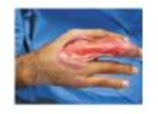
Concept explainers
Buruli Ulcer

Jacques liked living in the Democratic Republic of the Congo (DRC)-opportunities abounded for exploration, adventure, and wildlife photography, the countryside was beautiful, and he found the people generally friendly. It was on a photographic excursion in the east of the country that Jacques met a not-so-friendly resident of the DRC: an emerging mycobacterial pathogen.
The photographer thought little of the small insect bite he received while documenting wildlife in the swamps along the great Congo River, but he should have been concerned; Mycobacterium ulcerans had found a new home in his hand. Jacques would pay a grievous price for his lack of care.
He continued to ignore the infection when it produced a small, painless nodule. He even ignored it when his finger swelled to twice its normal size; it was painless, and he could still meet his busy schedule. But the bacterium was producing a potent toxin known as mycolactone that destroys cells below the skin, especially fat and muscle cells. Though his hand continued to swell, making it difficult to work normally, it remained pain free.

After six weeks of this condition, pain began suddenly and excruciatingly. The swollen finger ruptured, and a foul-smelling fluid saturated his camera. It was time to see a doctor.
The physician diagnosed Buruli ulcer, an emerging disease that affects more and more people each year as a result of human encroachment into the swamps where Mycobacterium ulcerans lives. After two surgeries to remove dead tissue and bacteria, several skin grafts, and two months of treatment with the antimicrobial drugs rifampicin and streptomycin, Jacques returned home to France with scars that forever remind him of his adventure with M. ulcerans.
- 1. What might be a reason why a Buruli ulcer is initially painless?
- 2. Why was it necessary to administer antibacterial drugs for two months rather than two weeks?
- 3. What environmental similarities exist in the endemic countries?
Want to see the full answer?
Check out a sample textbook solution
Chapter 19 Solutions
EP MICROBIOLOGY:W/DISEASES BY..-MOD.ACC
- Identify the indicated cavity (Fucus). a. antheridia b. conceptacel c. receptacle d. oogonium e. none of thesearrow_forwardIdentify the indicated structure (Saprolegnia). a. antheridium O b. oospore c.sperm d. auxospore e. tetraspore Of. zygosporearrow_forwardUsing information from the primary literature (several references have been provided as a starting point below) please answer the following question: Based on your review of the literature on rewilding, what are the major scientific pros and cons for rewilding? Please note that the focus of this assignment are the (biological) scientific issues associated with rewilding. As will be discussed in class, there are a number of non-scientific issues involved or implicated in rewilding, all ultimately affecting the public acceptability of rewilding. Although these issues are important – indeed, critical – in this assignment you should focus on the biological science issues and questions. Details: You must enumerate at least two pros and at least two cons. Your answer should be no more than 500 well-chosen words, excluding references. Think carefully about how best to organize and structure your answer. Aim for high information density: say a lot, but say it succinctly. Recall Nietzche’s…arrow_forward
- Using information from the primary literature (several references have been provided as a starting point below) please answer the following question: Based on your review of the literature on rewilding, what are the major scientific pros and cons for rewilding? Please note that the focus of this assignment are the (biological) scientific issues associated with rewilding. As will be discussed in class, there are a number of non-scientific issues involved or implicated in rewilding, all ultimately affecting the public acceptability of rewilding. Although these issues are important – indeed, critical – in this assignment you should focus on the biological science issues and questions. Details: You must enumerate at least two pros and at least two cons. Your answer should be no more than 500 well-chosen words, excluding references. Think carefully about how best to organize and structure your answer. Aim for high information density: say a lot, but say it succinctly. Recall Nietzche’s…arrow_forwardNow draw a rough sketch of what the control data might look like if in addition to the specific binding, there was also a considerable amount of nonspecific binding (again using a normal dose/response curve) (do % total bound ligand vs concentration)arrow_forwardWhat are functions of cuboidal cells in the kidney? Select all that apply. Concentration of gases Dilution of chemicals Secretion of molecules Nutrition to tissues Support of tissues Absorption of moleculesarrow_forward
- question1 In plants, epithelial tissue is only found as the outermost cell layer and acts as a barrier. In humans, epithelial tissue is found inside the body as well as on the surface. What function(s) does/do epithelial tissue carry out in humans? Select all that apply. Waste storage Filtration Oxygen transport Protection Diffusion Osmosis Absorptionarrow_forwardWhat words best describes this organism? a. Unicellular/nonmotile Ob. unicellular/motile c. colonial/nonmotile d. colonial/motile e. multicelluar O f. siphonous g. none of thesearrow_forwardIdentify the phylum or class. a. Euglenophyta b. Dinoflagellata c. Bacillariophyceae d. Oomycetes e. Phaeophyceae O f. Myxomycota g. Xanthophyceae ○ h. Chrysophyceae i. Dictyosteliomycota O j. Rhodophyta Ok. Chlorophyceaens I. Charophyceaensarrow_forward
 Medical Terminology for Health Professions, Spira...Health & NutritionISBN:9781305634350Author:Ann Ehrlich, Carol L. Schroeder, Laura Ehrlich, Katrina A. SchroederPublisher:Cengage Learning
Medical Terminology for Health Professions, Spira...Health & NutritionISBN:9781305634350Author:Ann Ehrlich, Carol L. Schroeder, Laura Ehrlich, Katrina A. SchroederPublisher:Cengage Learning Biology 2eBiologyISBN:9781947172517Author:Matthew Douglas, Jung Choi, Mary Ann ClarkPublisher:OpenStax
Biology 2eBiologyISBN:9781947172517Author:Matthew Douglas, Jung Choi, Mary Ann ClarkPublisher:OpenStax- Understanding Health Insurance: A Guide to Billin...Health & NutritionISBN:9781337679480Author:GREENPublisher:Cengage





